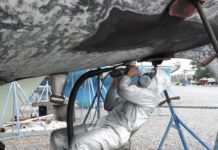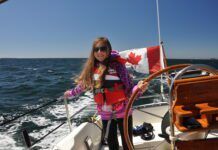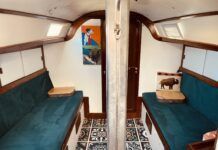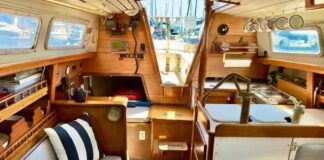In July 2006, Practical Sailortesters began a long-term bottom paint comparison between Interlux Micron Optima and Sea Hawk Monterey, two semi-hard ablative paints that are self-polishing, meaning that water movement during normal sailing cleans growth that may be trying to gain a foothold on the hull.
The test platform is a Norfolk, Va.-based Union 36, a full keel, heavy displacement sailboat whose cruising area is primarily the Chesapeake Bay and Intracoastal Waterway in Virginia and North Carolina. The boats hull, below the waterline, was divided into four equal sections, giving both bottom paints equal exposure: Sea Hawk was applied to the starboard bow and port aft section, while Micron Optima was applied to the port bow and starboard aft sections. Each section received three coats of its respective bottom paint, plus an additional coat at the waterline. Since its launch in July 2006, the test boat has seen normal use, ranging from monthly weekend and day trips to several weeklong cruises.
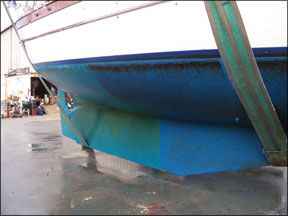
When testers recently hauled the Union, they evaluated the overall amount of growth, differences in the amount per panel and differences in the growth on the same panel (waterline vs. the keel, for example), and variations in the amount of growth between starboard and port side panels. (Port being the “sunny” side in this case.) Testers also wanted to see how much bottom paint remained, and whether it was in need of repainting.
After 17 months of use, all sections of the hull were amazingly clean with only moderate slime or “fuzz” and virtually no hard growth, while the prop and shaft-which require cleaning at least every three months to remain usable-were considerably fouled.
The Micron Optima panels had only a light film of slime present. Testers noted that this layer was thicker at the waterline, with the sunny port bow showing more concentration than the starboard stern.
The Sea Hawk Monterey sections had the same fuzzy, algal growth at the waterline, however the concentration was heavier and covered a greater percentage of both Monterey panels. As with the Optima, the heaviest concentrations were at the waterline and the port stern.
All sections were easily cleaned with a rub of the hand. Even after testers power-washed the hull, both paints were still intact. (Although both paints still had life in them, Optimas departure from the market convinced us to begin a new head-to-head test. The Union is set to be repainted this month with two water-based coatings. Stay tuned for more.)
We used the same test procedures on two other boats. A 25-foot Hunter in Sarasota, Fla., also was painted with Optima and Monterey. As reported in November, the portions of the boat that were painted with Monterey were already growing small barnacles at the 12-month mark. Three months later, the Optima also began to grow barnacles. At 17 months, it was time for a haulout. Clearly, the waters of the Chesapeake Bay were much kinder to these paints than those warm waters in Florida.
To see whether a cheap sloughing paint could hold its own with a high-priced competitor for one season, we pitted Interlux Micron 66 against Interlux Tarr and Wonson, a sloughing “work boat” paint that sells for $74 a gallon at Jamestown Distributors (www.jamestowndistributors.com). The paints were applied to one of our work boats, a 21-foot Parker powerboat, docked in Sarasota. At 12 months, both paints were holding barnacles at bay, but at 15 months, the Tarr and Wonson was obviously losing its punch, as barnacles began congregating near the waterline. At 17 months, the Micron 66 was still barnacle-free, while the Tarr and Wonson had given up the ghost.
CONCLUSION
Our test boats antifouling performances seem consistent with our panel testing. The Monterey is an effective multi-season paint, at least in the Chesapeake, and the Micron 66 also is a potent concoction. For single-season coverage, the Tarr and Wonson works, but don’t expect miracles. Because the Tarr and Wonson is a soft paint, clean softly, if at all. It isn’t meant for scrubbing.


















